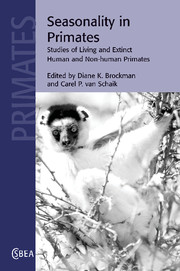Book contents
- Frontmatter
- Contents
- List of contributors
- Preface
- Part I Introduction
- Part II Seasonal habitats
- Part III Seasonality and behavioral ecology
- Part IV Seasonality, reproduction, and social organization
- 10 Seasonality and reproductive function
- 11 Seasonality of primate births in relation to climate
- 12 Energetic responses to food availability in the great apes: implications for hominin evolution
- 13 Human birth seasonality
- 14 Seasonality, social organization, and sexual dimorphism in primates
- Part V Seasonality and community ecology
- Part VI Seasonality and human evolution
- Index
- References
11 - Seasonality of primate births in relation to climate
Published online by Cambridge University Press: 10 August 2009
- Frontmatter
- Contents
- List of contributors
- Preface
- Part I Introduction
- Part II Seasonal habitats
- Part III Seasonality and behavioral ecology
- Part IV Seasonality, reproduction, and social organization
- 10 Seasonality and reproductive function
- 11 Seasonality of primate births in relation to climate
- 12 Energetic responses to food availability in the great apes: implications for hominin evolution
- 13 Human birth seasonality
- 14 Seasonality, social organization, and sexual dimorphism in primates
- Part V Seasonality and community ecology
- Part VI Seasonality and human evolution
- Index
- References
Summary
Introduction
It is well established that most primate populations show at least some seasonality in the frequency of births (Lancaster & Lee 1965; Lindburg 1987; Di Bitetti & Janson 2000). There are two major questions concerning this seasonality: (i) what determines the narrowness of the peak (if there is one)?, and (ii) what determines when the peak occurs? Because these two questions deal with distinct kinds of hypotheses and data analyses, we will treat them separately. In this chapter, we attempt to cover the background, current hypotheses, and observed patterns for each topic by analyzing quantitative birth data on 70 wild populations of primates; there are many more data sets on captive primates, but we do not deal with those here. To streamline the presentation, the details of how we acquired the data set and performed statistical analyses are given in Appendix 11.1. We conclude with a brief summary of the results and implications for primate responses to seasonal variation in general.
Before discussing adaptive hypotheses for birth seasonality, it is important to distinguish seasonality from synchrony. The patterns and causes of these two phenomena are distinct. High seasonality in births necessarily will produce a high level of synchrony, but the reverse is not true. Births can be synchronized within a group but less synchronized between groups. Factors that favor or cause within-group synchrony of births, such as predation on infants (Boinski 1987) and infanticide (Butynski 1982), may show little seasonality and thus may not select for high population-wide seasonality of births (Di Bitetti & Janson 2000).
- Type
- Chapter
- Information
- Seasonality in PrimatesStudies of Living and Extinct Human and Non-Human Primates, pp. 307 - 350Publisher: Cambridge University PressPrint publication year: 2005
References
- 63
- Cited by



